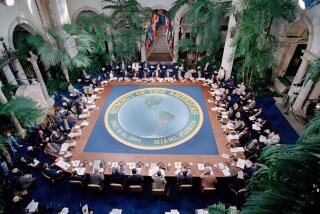Lost Resources Called No. 1 Latin Probelm
- Share via
RIO DE JANEIRO — Latin America’s hope for sustained economic development has faded in the 1980s as financial resources have left the region faster than they have come in, creating the area’s overriding problem today, economists of a United Nations commission say.
About $147 billion in Latin American savings, sorely needed for development, has gone instead to developed countries since 1982 in a “net transfer of resources,” representatives of the U.N.’s Economic Commission for Latin America and the Caribbean said at a meeting this week.
“What it means is that investment is way down in Latin America,” Gert Rosenthal, the organization’s new executive secretary, said in an interview.
Representatives of most Latin American countries agreed that major reductions of interest payments on the region’s $410-billion foreign debt are essential to any solution.
“Latin America says it needs debt relief so that it can grow--so that it can pay off its debt,” Rosenthal said. Major debt relief would require sacrifices by lenders, “and lenders have not been too sympathetic to that,” he added. “They have to answer to their stockholders.”
Meanwhile, U.S. participants in the commission meeting emphasized private business expansion--rather than debt relief--as the best way to generate new investment and development.
“Evidence shows that where governments encourage, rather than hinder, the development of entrepreneurship, private initiative will point the way to economic growth,” said Richard Williamson, an assistant secretary of state and head of the American delegation.
Some Debt Relief
Despite such differences in emphasis, Rosenthal said industrialized creditor countries are gradually accepting the need to lighten Latin America’s debt burden.
“There has been progress on debt relief--certainly not enough, but things have been moving in the right direction,” he said.
The Latin American debt burgeoned during the middle and late 1970s, when U.S. and European banks recycled abundant petrodollars throughout the region. The easy credit financed a growth boom, which in turn attracted billions of dollars in foreign investment capital. The net transfer of resources was strongly in Latin America’s favor, surpassing $15 billion a year in 1978 and 1979.
But the flow was reversed sharply in 1982, when Mexico became so financially overextended that it suspended interest payments on its debt. Startled banks stopped lending to most of Latin America.
Meanwhile, interest rates were high and debt service was costing Latin America more than $30 billion a year. Overburdened economies were faltering, and foreign investment slowed to a trickle.
“It has not been an attractive place for a rational investor to bring his money in,” Rosenthal said. “Rather, there has been an outflow of capital.”
The net transfer of resources out of Latin America grew to $31.6 billion in 1985. With declining interest rates, it receded to $16.8 billion in 1987 but remains “overwhelming,” according to a report prepared for the Rio meeting.
“This transfer defies all logic,” the report said.
Economies Shrinking
When Latin America was receiving a net inflow of resources, nearly one-fourth of its gross domestic product was normally saved and invested, Rosenthal said. Total savings have stayed roughly the same, but about one-third of the savings now are transferred abroad, so investment is down to 15% or 16% of gross domestic product, he said.
The slump in economic growth has meant that Latin America’s per-capita product in 1987 was 5.5% less than in 1980.
Some increased foreign lending to Latin America could help solve the problem, but massive fresh credit “is not a realistic solution,” Rosenthal said. And although increased exports could also help bring in more resources, he said, an export boom is unlikely because demand in industrialized countries for Latin American products is weak.
In the short run, Rosenthal concluded, “you would have to look for a short-term solution in getting greater relief from the debt.”
More to Read
Sign up for Essential California
The most important California stories and recommendations in your inbox every morning.
You may occasionally receive promotional content from the Los Angeles Times.













